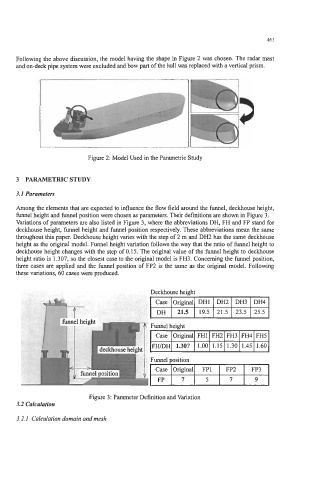Page 486 - Practical Design Ships and Floating Structures
P. 486
46 1
Following the above discussion, the model having the shape in Figure 2 was chosen. The radar mast
and on-deck pipe system were excluded and bow part of the hull was replaced with a vertical prism.
?
Figure 2: Model Used in the Parametric Study
3 PARAMETRIC STUDY
3.1 Parameters
Among the elements that are expected to influence the flow field around the funnel, deckhouse height,
funnel height and funnel position were chosen as parameters. Their definitions are shown in Figure 3.
Variations of parameters are also listed in Figure 3, where the abbreviations DH, FH and FP stand for
deckhouse height, funnel height and funnel position respectively. These abbreviations mean the same
throughout this paper. Deckhouse height varies with the step of 2 m and DH2 has the same deckhouse
height as the original model. Funnel height variation follows the way that the ratio of funnel height to
deckhouse height changes with the step of 0.15. The original value of the funnel height to deckhouse
height ratio is 1.307, so the closest case to the original model is FH3. Concerning the funnel position,
three cases are applied and the funnel position of FP2 is the same as the original model. Following
these variations, 60 cases were produced.
Case Original DH1 DH2 DH3 DH4
DH 21.5 19.5 21.5 23.5 25.5
Case Original FHl FH2 FH3 FH4 FH5
FWDH 1.307 1.00 1.15 1.30 1.45 1.60
Case Original FPl FP2 FP3
FP 7 5 7 9
Figure 3: Parameter Definition and Variation
3.2 Calculation
3.2. I Calculation domain and mesh

